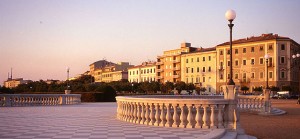Tourist attractions in Tuscany: The Etruscan Coast.
The coastline that from Livorno goes down to Piombino owes its name to the ancient civilization that first inhabited Tuscany, the Etruscans.
The Etruscan coast is one of the classic itineraries for a road trip in Tuscany. The area isn’t famous for its beaches as much as it is for its naturalistic beauty, and for the characteristic small towns you’ll find along the road. Moving from town to town you will also have the chance to taste some delicious traditional dishes and wines.
A Tour of the Etruscan Coast
Livorno. Start your tour from the North and from the biggest coastal town of Tuscany: Livorno has been heavily damaged by bombings during World War II and then in large part rebuilt. Just a few buildings remains of the old medieval town, but you will surely enjoy a tour of “little Venice” district.
Castiglioncello. This little seaside town located 30km South of Livorno will set you immediately in the typical 1950’s Italian atmosphere. Seat at one of the tables of Caffè Ginori, in Piazza della Vittoria: this is the true centre of the town, and it was the favourite place of Marcello Mastroianni, who owned a villa in the surroundings.
Bolgheri and surroundings. A tiny hamlet enclosed by stone walls and overlooked by a medieval castle, largely renovated in the 19th century: Bolgheri is one of the most charming places you’ll have the chance to visit in this part of Tuscany. Tourists though visit the town for its renowned (and expensive) little shops, and for its wine, the Sassicaia, produced only here and famous all over the world.
From Bolgheri, driving westward for 5,7km along the SP16 you’ll reach San Guido: here you can get a full list of the wine producers of the area who are part of the Wine and Olive Oil road consortium, that promotes an interesting enogastronomic itinerary (you’ll find more detailed information in the paragraph dedicated to the itinerary here).
Castagneto Carducci. Driving Southward from Bolgheri, following a back road that crosses a deep wood, and then twists and turns across olive groves and vineyards, you’ll get to a little citadel. This is Castagneto Carducci. Behind the walls you’ll discover a charming town made of old houses and narrow alleys, overlooked by the castle of the Gherardesca family, who used to rule the town. Once a true fort, the building has been renovated and turned into an elegant palace during the 18th century. Don’t forget to pay a visit to he nearby hamlet of Sassetta: at the gates of the town you’ll find a map that depicts a variety of routes you can take for a naturalistic hike in the area.
San Vincenzo. This seaside resort draws crowds of locals and tourists during summer, not much to see here, but, if you happen to stop by during the hottest weeks of the year, you could enjoy its sandy beaches. Pay a visit to the archeological park “Parco Archeominerario di San Silvestro” nearby: the valley near San Vincenzo has been an important minerary area since the Etruscan times; inside this unique archaeological site you’ll find the ovens Etruscans used to melt copper more than 22 centuries ago. Inside the park lies the abandoned minerary town of Rocca San Silvestro, built in the 14th century and reachable only through a little underground train that runs through the tunnels of the old lead and copper mines.
Golfo di Baratti. This gulf is named after the main town on the coastline, Baratti, 12km South of San Vincenzo. The main attraction around here is surely the archaeological park of Baratti and Populonia, a vast area with 5 different itineraries that will lead you to the ruins of ancient Etruscan tombs. The easiest to reach is San Cerbone’s necropolis, near to the visitor center: here you can visit the Tomba dei Carri, an ancient circular construction with a diameter of 28 meters.
From the visitor centre you can also take the route called Via delle Cave: a 2 hours hike among the woods to discover ancient caves, once sandstone mines, turned into tombs. The Via della Romanella, leading to the Etruscan acropolis of Populonia, requires a bigger effort: it’s roughly a 2 hours and a half walk; but you can reach the ruins of the Etruscan temple that lie there also by car, following the directions from Baratti to Populonia, a charming hamlet with just 3 streets guarded by a fifteenth-century castle.







